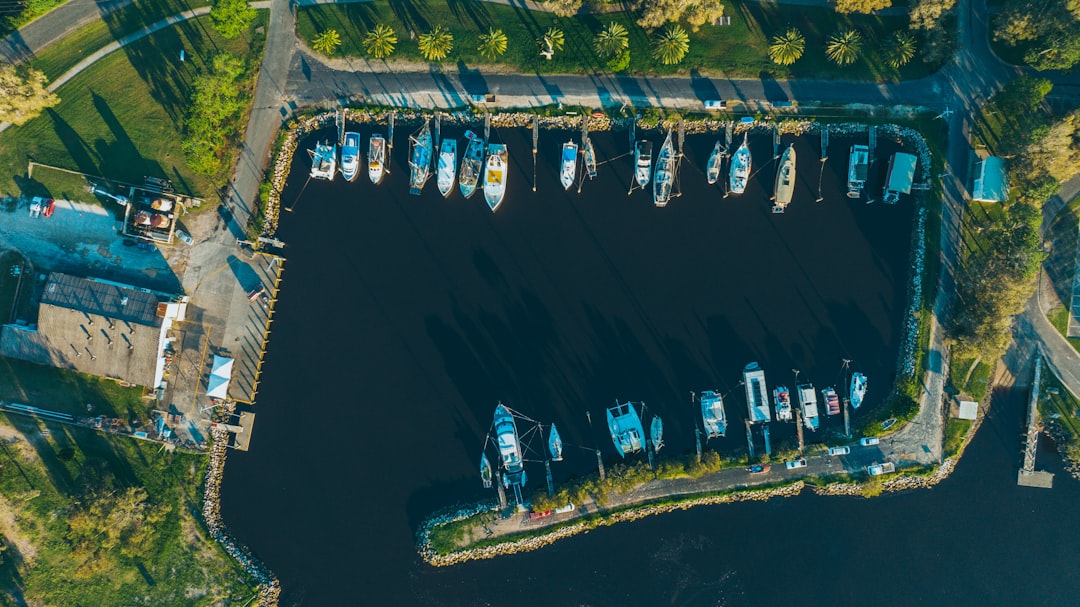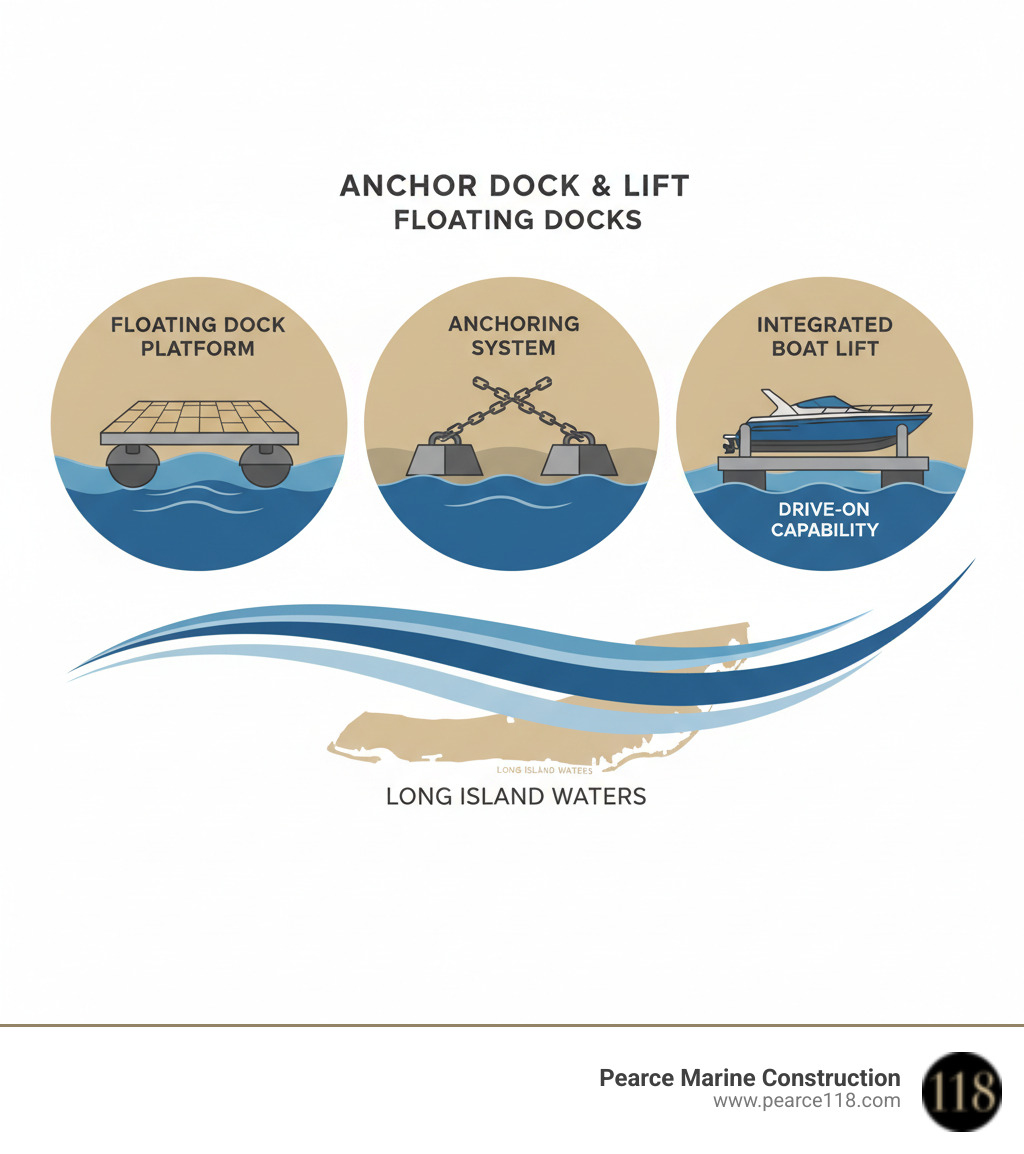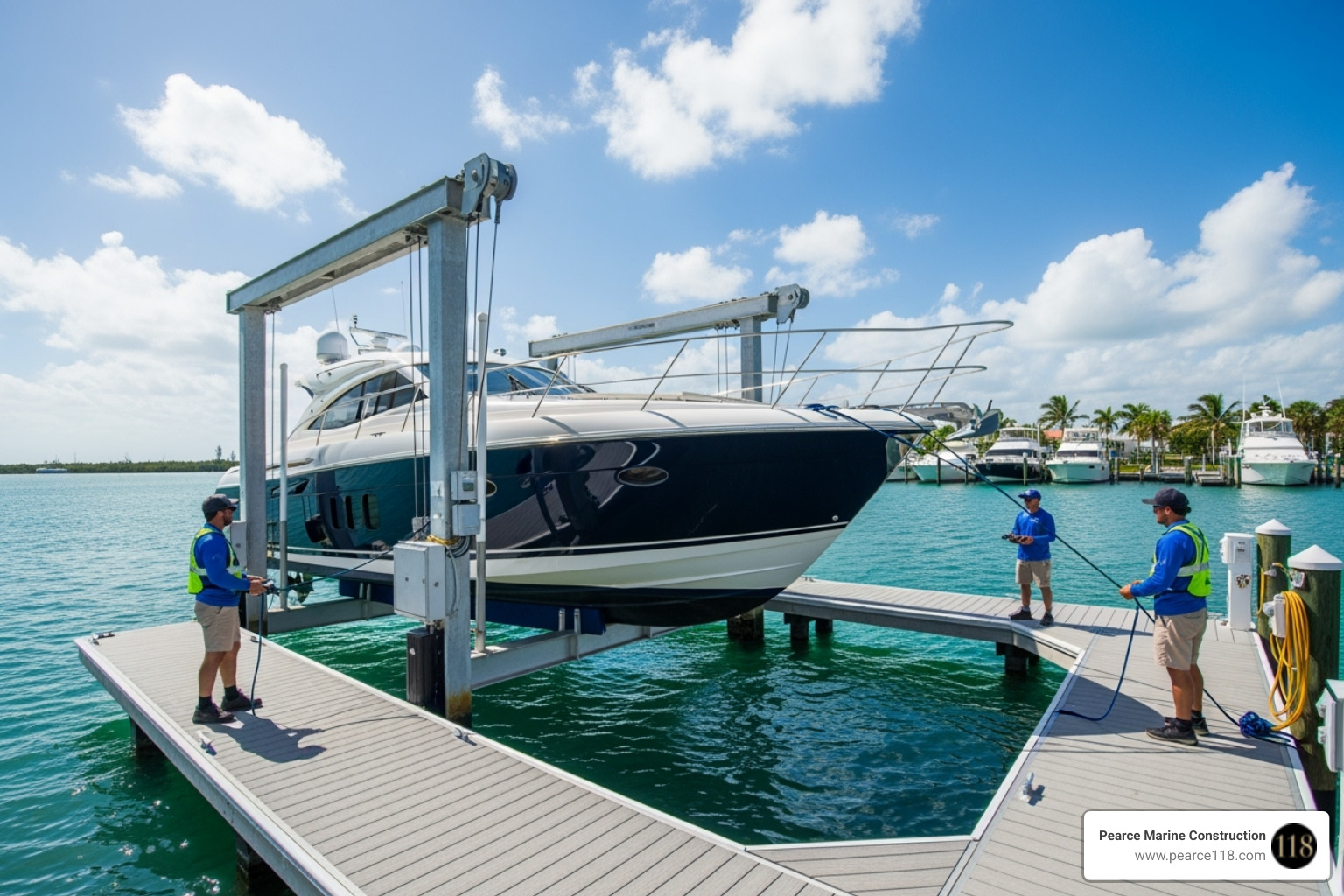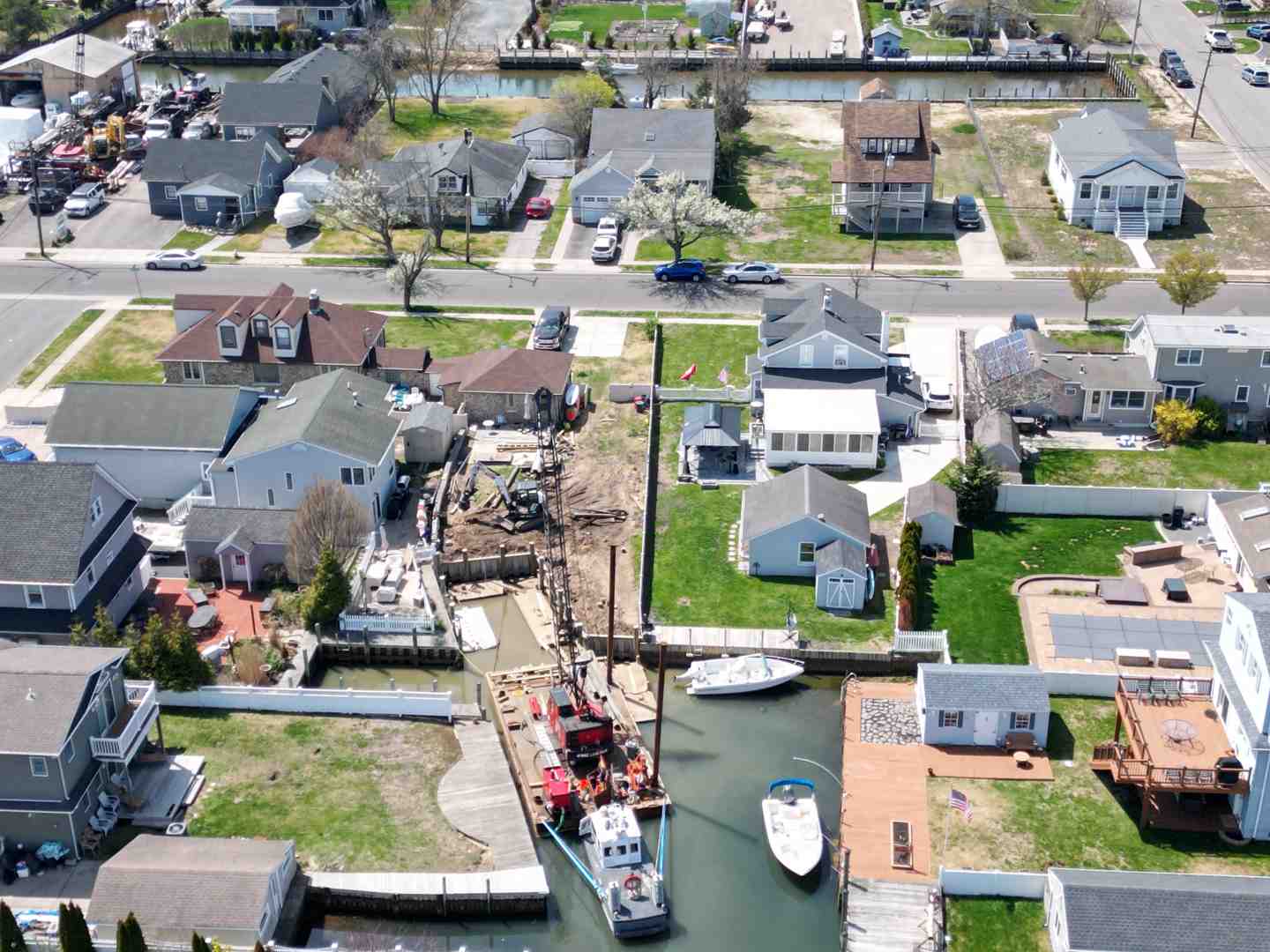The Ultimate Guide to Anchor Dock & Lift Floating Docks

Why Anchor Dock and Lift Floating Docks Are Essential for Long Island Waterfront Properties
Anchor dock and lift floating docks are a versatile and protective solution for Long Island's dynamic waterfront. These systems integrate three key components: a floating platform that adapts to water levels, a robust anchoring system for security, and a boat lift to protect your watercraft. This combination offers superior protection for both your dock and boat.
Key benefits include:
- Weather Resilience: Adapts to storm surge better than fixed docks.
- Water Level Adaptation: Automatically adjusts to tides and seasonal fluctuations.
- Investment Security: Protects your dock and boat with one integrated system.
- Improved Safety: Maintains a consistent boarding height.
For Long Island property owners, this integrated system is the best defense against fluctuating water levels and storm exposure. A senior dock specialist notes that proper anchoring is what separates a dock that survives a storm from one that becomes a liability. On Long Island, with its nor'easters and hurricanes, the anchoring system is the foundation of your waterfront investment's safety and longevity.

Related content about anchor dock and lift floating docks:
Why Proper Anchoring is the Foundation of Your Floating Dock
Improper anchoring can turn your dock into a floating liability. When anchor dock and lift floating docks break free, they become a serious navigation hazard, threatening other boaters and property. The financial fallout can be devastating, including replacement costs and liability for damages. A loose dock can also accelerate shoreline erosion by scraping against bulkheads and seawalls.
Local authorities in Nassau and Suffolk Counties take this seriously, imposing significant fines for docks that become navigational hazards. Maritime accident reports often cite improperly secured marine structures in collision incidents.
The good news is that properly anchored floating docks outperform fixed docks in severe weather. As documented by FEMA, floating docks can protect boats during storms more effectively. They rise with the storm surge, absorbing energy rather than fighting it. This resilience is crucial on Long Island. A well-engineered system, including how you secure floating dock to shore, also helps prevent erosion. The anchoring system beneath the surface is the true foundation of your floating dock's success and safety.
A Deep Dive into Floating Dock Anchoring Systems
When building anchor dock and lift floating docks, the anchoring approach is different from fixed docks. Floating docks need a system that allows vertical movement with the tides while preventing horizontal drift. Our expertise in floating dock anchoring systems is crucial for your Long Island investment.
Deadweight Anchors: The Tried-and-True Method
Concrete blocks are the workhorses of dock anchoring. However, concrete loses about half its weight underwater due to buoyancy. A 1,200-pound block only provides 600 pounds of holding power. For this reason, we often install a minimum of 600 pounds of effective anchor weight at the corners, with more points for larger docks. Granite blocks offer more weight in a smaller footprint. Deadweight anchors are reliable and cost-effective but require heavy equipment for installation. Our team has the specialized equipment to position these dock anchors for a floating dock correctly.
Embedment Anchors: Superior Holding Power
For challenging bottom conditions, embedment anchors offer superior holding power with a smaller footprint by burying themselves into the seabed.
- Helix and screw anchors are screwed into the seabed, creating a strong mechanical grip with minimal disturbance.
- Mushroom anchors are ideal for soft, muddy bottoms common in Long Island's protected bays. They use suction and bury themselves over time, becoming more secure.
Embedment anchors provide excellent holding power without the massive weight of concrete blocks.
Structural Anchoring: Pipes, Piles, and Stiff Arms
For the most challenging conditions, structural systems offer robust solutions.
- Pipe and collar systems are great for shallower waters. The dock slides up and down pipes driven into the seabed.
- Piling and hoop systems are the gold standard. The dock is attached to driven pilings with hoops or brackets, allowing it to ride up and down with the tide.
- Stiff arm systems use rigid arms to connect the dock to a fixed point on shore, allowing vertical movement while ensuring horizontal stability. They are ideal where pilings are not practical.
Our team assesses your site to determine the best approach for your anchoring a floating dock project.
Designing Your System: Site Assessment and Shoreline Connections
Before construction of your anchor dock and lift floating docks begins, a thorough site assessment is essential. Every waterfront in Nassau and Suffolk Counties is unique, and understanding its specific characteristics is the key to a long-lasting dock system. The design process starts with how to anchor a floating dock to shore, creating a system that harmonizes with your environment.
Assessing Your Waterfront Environment
A site assessment is like getting to know your waterfront's personality. We analyze several key factors:
- Water depth and bottom type: Determines the best anchor type. Rocky bottoms suit concrete blocks, while muddy bottoms may require mushroom anchors.
- Wave action, fetch, and currents: Dictate the amount of force the anchoring system must withstand.
- Tidal fluctuations and seasonal water levels: Influence chain lengths and gangway design.
- Ice conditions: May require seasonal removal or specialized ice management strategies.
Connecting Your Floating Dock to the Shore
The gangway or ramp is an engineered connection that must accommodate constant movement while providing safe access.
- Hinged gangways are the most popular solution, using pivoting connections to rise and fall with the dock.
- Stiff arm systems can serve as both an anchor and a shore connection.
- Piling hoops create a sliding connection to driven pilings.
- Deadweight winch systems offer adjustability for extreme water level changes.
We match the connection method to your site conditions. Our guide on how to attach floating dock to shore explores these options further.
The Role of a Floating Dock Shore Anchor
The shore anchor is the critical land-based connection. It's the foundation that prevents the entire system from pulling away from shore.
- Concrete footings provide a reliable, immovable base.
- Bedrock hardware can be used to bolt directly into stone for an incredibly strong connection.
- Existing structures like bulkheads or seawalls can sometimes be used after we verify their structural integrity.
A properly engineered floating dock shore anchor is the unsung hero that keeps your investment secure.
Integrating Lifts with Anchor Dock and Lift Floating Docks

Integrating a boat lift creates a system where your boat is protected and your dock remains functional, all moving in harmony with Long Island's tides. This is the core of anchor dock and lift floating docks. The engineering requires careful planning to create boat lifts that complement the natural movement of a floating dock.
How Boat Lifts Work with Floating Docks
The primary advantage of an integrated lift is maintaining a consistent height between your boat and the dock, regardless of the tide. This makes boarding safe and easy. When we attach lifts to the dock frame, we engineer the entire structure to handle the concentrated loads. This means reinforcing the frame to support the boat's weight and the dynamic forces of the lift's operation. We build the dock with these forces in mind to ensure stability. Common integrations include various types of floating boat lifts, including those designed for personal watercraft (PWCs).
Anchoring Considerations for Anchor Dock and Lift Floating Docks
Adding a boat lift dramatically increases the anchoring requirements. The system must now hold the dock, the lift, and the full weight of your boat. This increased load requires a stronger anchoring design. We install stronger anchoring points and often additional anchors near the lift to handle the specific stresses. The dock's stability during lift operation is a key consideration in our construction. We engineer a comprehensive boat dock anchor system where every component works together to protect your watercraft.
Construction and Maintenance Best Practices
Building and maintaining anchor dock and lift floating docks properly is the key to a long-term investment. Following proven construction and maintenance practices ensures your system will last for decades.
| Anchor Type | Bottom Type | Water Depth | Holding Power | Cost (General) | Installation |
|---|---|---|---|---|---|
| Concrete Block | Sand, Gravel, Firm Mud | Any | Medium-High | Low-Medium | Heavy Equipment Needed |
| Helix Anchor | Sand, Mud, Clay | Any | High | Medium-High | Specialized Equipment |
| Stiff Arm | Any | Any (needs shore/pile) | High | Medium-High | Requires Fixed Point |
| Piling (with Hoops) | Any | <15-18 ft | Very High | High | Specialized Equipment |
Calculating Anchor Weight and Chain Scope
Getting the math right is critical for surviving Long Island weather.
- Anchor Weight: We start with a minimum of 600 pounds of effective anchor weight at the corners. Since concrete loses about half its weight underwater, this requires a 1,200-pound block. Additional anchors are spaced every 24 to 30 feet.
- Chain Length: Chains should be 1.5 to 2 times the maximum water depth, with extra length to account for tidal range.
- Materials: We use 3/8 galvanized chain for most applications and marine-grade stainless steel hardware in saltwater environments to prevent corrosion. Never mix different metal types.
Professional Installation and Permitting
Complex anchor dock and lift floating docks systems require professional installation. We recommend it for water deeper than 8-10 feet, helical anchor installation, or areas with heavy wave exposure. The peace of mind and durability are worth the investment.
Marine construction in Nassau or Suffolk County almost always requires permits. These regulations protect the environment and ensure safety. We guide clients through the permitting process for any floating dock construction project.
Long-Term System Maintenance
Regular maintenance ensures longevity.
- Seasonal Inspections: Perform thorough checks in spring and fall. Look for wear, check fasteners, and adjust tension.
- Post-Storm Inspections: Always check your system after a major weather event.
- Hardware and Flotation: Annually inspect all hardware for corrosion and check flotation elements for damage.
- Winterization: In areas with significant ice, docks may need to be removed. In many Long Island locations, proper preparation like adding chain slack is sufficient.
Frequently Asked Questions about Anchor Dock & Lift Floating Docks
Over the years, we've fielded countless questions from Long Island property owners considering anchor dock and lift floating docks. These are the three most common.
How much weight is needed to anchor a floating dock?
The answer depends on your specific site, but a good starting point is a minimum of 600 pounds of effective anchor weight at each of the furthest corners. "Effective" is key, as concrete loses about half its weight underwater. So, a 1,200-pound block provides 600 pounds of holding force. We typically add additional anchors every 24 to 30 feet along the sides. These are baseline numbers; we calculate the final requirements based on your dock's size, exposure, and whether it includes a boat lift.
How do floating docks handle storms and fluctuating water levels?
This is their greatest strength. Floating docks are designed to rise and fall with water levels, which keeps the boarding height consistent. During storms, this ability to move with the waves makes them more resilient than rigid fixed docks. However, this resilience is entirely dependent on proper construction. Sufficient chain slack (typically 1.5 to 2 times the water depth plus tidal range) and a well-designed anchor pattern are essential to allow the dock to adapt without drifting or sustaining damage.
Can I add a boat lift to my existing floating dock?
Often, yes, but it requires a thorough professional assessment. We must evaluate your dock's structural integrity to ensure it can handle the added weight and dynamic forces of a lift. More importantly, we must analyze your current anchoring system. Adding a lift significantly increases the load, and the existing anchors are often inadequate. In most cases, installing stronger or additional anchors is necessary to create a safe and stable anchor dock and lift floating docks system.
Conclusion
Building a successful anchor dock and lift floating docks system is like creating a symphony – every element must work in perfect harmony. The concrete anchors holding steady on the bottom, the chains allowing graceful movement with the tides, the robust dock frame supporting your boat lift, and the shore connections keeping everything secure. When one component fails, the entire system suffers.
We've seen too many waterfront properties where corners were cut during construction, leading to costly repairs and sleepless nights during storm season. A dock that breaks free during a nor'easter doesn't just damage itself – it becomes a battering ram that can destroy neighboring boats and property. That's why we approach every project with the understanding that your waterfront investment deserves nothing less than generational expertise.
At Pearce Marine Construction, we've built our reputation on understanding Long Island's unique marine environment. From the protected coves of Cold Spring Harbor to the more exposed waters of the Great South Bay, each location presents its own challenges. Our woman-owned company brings meticulous craftsmanship to every anchor placement, every chain calculation, and every lift integration.
The complexity of these systems – from calculating proper anchor weights to ensuring adequate chain scope for tidal fluctuations – requires deep knowledge that comes from years of hands-on experience. We've learned that a properly engineered anchor dock and lift floating docks system isn't just about following formulas; it's about understanding how wind patterns, bottom conditions, and seasonal changes work together to create forces that your anchoring system must withstand.
For Nassau and Suffolk County property owners, this expertise translates into peace of mind. When hurricane warnings fill the weather reports, you won't be scrambling to protect your dock – it will already be designed to handle whatever Mother Nature delivers.
To explore custom boat docks and floating docks for your waterfront property, contact our team today. We're ready to help you create a system that protects your investment and improves your waterfront lifestyle for decades to come.
Bring Your Vision to Life
Whether you're planning a custom dock, seawall, or boat lift, our experienced team is ready to deliver high-quality marine construction tailored to your needs. Pearce Marine Construction brings craftsmanship, precision, and a deep understanding of Florida’s waterways to every project. Let us help you create a durable, beautiful solution that stands the test of time. Get in touch now for a personalized estimate!






